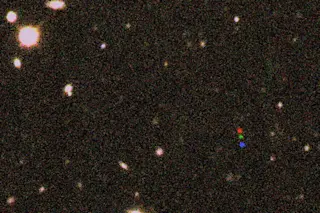The discovery images of 2012 VP113. The dwarf planet moved between each image as seen by the red, green and blue dots. Credit: Scott S. Sheppard/Carnegie Institution for Science Even after all these years, the solar system can still surprise us. Not just with the occasional new rock — a nifty asteroid, or interesting comet — but sometimes we even find new minor planets and, if really lucky, an entire new region. Now astronomers have done just that: findings announced today suggest there's a never-before-seen minor planet orbiting the sun beyond Pluto. And, beyond that, it's possible a major planet is hiding out in the darkest, farthest regions of the solar system too. If the researchers are right, their discovery would redefine the edges of our planetary neighborhood.
We have a solid grasp of the innermost parts of the solar system: the rocky planets and asteroids closest in, from 0.39 ...














